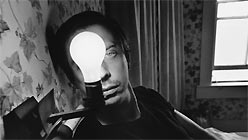When Jeffrey Fraenkel opened his gallery in 1979, he wrote a love letter of sorts to the photographer Lee Friedlander, asking him to be among the first artists represented. Thirty-one years later, Fraenkel Gallery has become one the pre-eminent photography galleries in the country, and Friedlander remains on its impressive roster. The current show, Lee Friedlander or How I Got From There to Here In 100 Photographs Or Less, marks Friedlander’s 14th with the gallery. Exhibiting roughly two photographs from every year between 1960-2010, this systematic approach seems to echo the photographer’s own no-nonsense approach to his craft.

“Memphis,” 2003, Lee Friedlander
Covering fifty years in three rooms, time passes quickly in this show. The black and white silver gelatin prints (all made by the artist himself) grow larger and change formats with time, but the subject matter — curious and slightly unnerving pictures of modern life — feel distinctively Friedlander throughout. His 1968 self portrait with a raw light bulb obscuring his face, simply titled Cape Cod, Massachusetts is a classic example: as simple as it is strange, it manages to be simultaneously laconic and darkly funny. Likewise, Memphis, taken in 2003, depicts a simple perspectival joke — an inverse-triangle street sign mirroring a pyramid structure in the distance. The image escapes any trappings of irony; like all of his work here, it is more a peculiar observation than an easy trick. This is the enduring appeal of Friedlander: no matter his age, he is a ceaseless wanderer of the American nowhere, a Beat with humor, clumsy, yet full of grace.
I can’t recall ever meeting a photographer who didn’t appreciate Friedlander’s work, yet he has always seemed to me to be a distinctively male photographer. Poll any class of photography students: overwhelmingly it is the boys who list Friedlander as a direct influence. I’ve never been able to put my finger on exactly why, but this selection gives me a clue. In this show I notice the most obvious thing: while Friedlander includes many portraits of women, including some nudes, he is the only male that appears (and what incredible self portraits they are). These are not only pictures by a man, but they are/he is the only man in his world. Among Friedlander’s most well-known works are a collection of eerie images of his own shadow on the backs of other people on the street; it is telling that these unsuspecting subjects are all women. This simple insight provides me with a new reading of Friedlander, one that helps me to understand the scope of these pictures as less neutral than I previously believed.

“New York City,” 1960, Lee Friedlander


